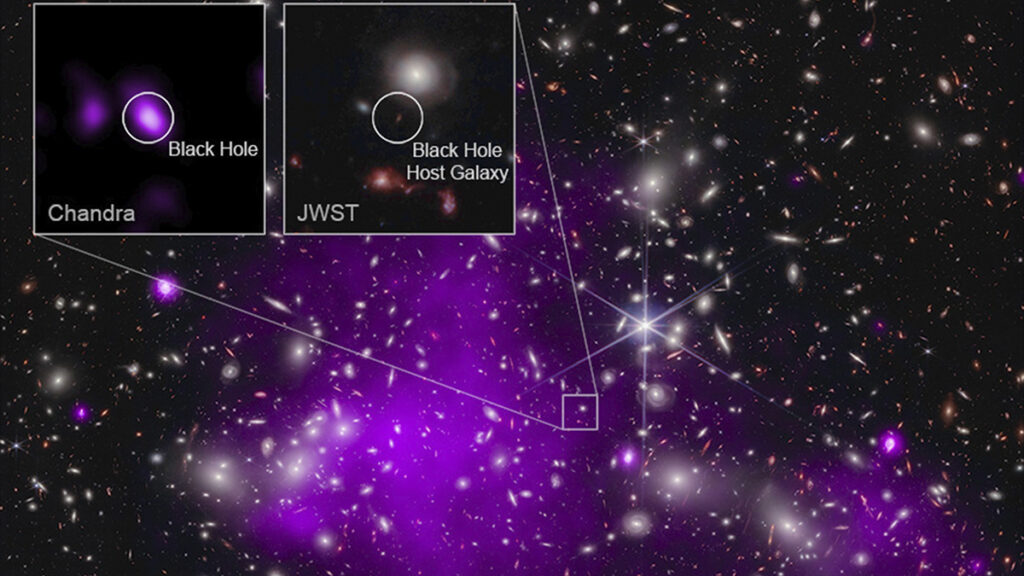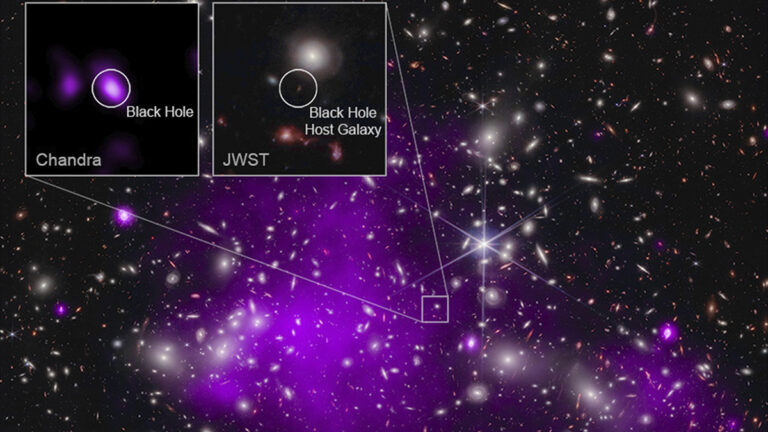Researchers identify the most ancient black hole to date, a colossal entity formed 470 million years following the Big Bang.
The results, released on Monday, validate previously speculative notions that supermassive black holes were present in the early stages of the universe. In the past year, NASA’s James Webb Space Telescope and the Chandra X-Ray Observatory collaborated to gather these observations.

Considering the universe’s age of 13.7 billion years, this black hole is estimated to be 13.2 billion years old. What’s even more remarkable for scientists is its enormous size, surpassing the black hole in our Milky Way by a factor of ten.
Lead author Akos Bogdan from the Harvard-Smithsonian Center for Astrophysics suggests that this black hole is estimated to have a mass ranging from 10% to 100% of all the stars in its galaxy. This is a significant departure from the much smaller proportion seen in black holes in our Milky Way and nearby galaxies, typically making up only around 0.1% of the total mass, as noted by Bogdan.
Yale University’s Priyamvada Natarajan, a contributor to the study published in the journal Nature Astronomy, remarked on the astonishing presence of such a colossal entity in the early stages of the universe, stating, “It’s truly remarkable to find this massive black hole already in place within its galaxy at such an early point in the universe’s history.”
According to the researchers, this black hole is believed to have formed from immense clouds of gas that collapsed within a neighboring galaxy adjacent to one containing stars. Following the merger of these two galaxies, the black hole assumed dominance.
The detection of this black hole via X-rays by the Chandra X-Ray Observatory undeniably confirms its identity as a black hole, as Natarajan points out. X-rays capture the gas being gravitationally drawn into the black hole, accelerating and causing it to emit intense X-ray radiation.
This particular black hole is classified as a quasar because of its active growth and the blinding brightness of the gas surrounding it, as Natarajan mentioned.
According to scientists, it’s possible that the Webb telescope alone has detected a black hole that is 29 million years older, but this observation has not been confirmed in X-rays yet. Natarajan anticipates the discovery of more early black holes, possibly not as distant but still quite remote.
“We are on the brink of a new era in our understanding of the universe, and I believe this is just the beginning,” she remarked.
The two space telescopes, Webb and Chandra, employed a technique called gravitational lensing to magnify the region of space where the galaxy UHZ1 and its black hole are situated. By using the light from a much closer cluster of galaxies, located a mere 3.2 billion light-years from Earth, they were able to enhance the visibility of UHZ1 and its black hole, which are positioned much farther in the background.
“It’s a relatively faint object, and, thanks to fortuitous circumstances, nature has provided us with this magnification,” Natarajan explained.
Launched in 2021 to a location 1 million miles away from Earth, Webb is the largest and most potent astronomical observatory ever deployed in space, observing the universe in the infrared spectrum. In contrast, the older Chandra possesses X-ray vision and was launched into orbit in 1999.
“I’m truly amazed that Chandra continues to make remarkable discoveries 24 years after its launch,” Bogdan expressed.
Do not forget to share your opinion with us to provide you with the best posts !





0 Comments